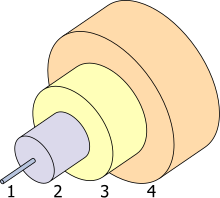
Back Fibra òptica de mode únic Catalan Jednovidové optické vlákno Czech Fibra óptica monomodo Spanish Fibra óptica monomodo Galician Fibra ottica monomodale Italian Single-modus fiber NB Światłowód jednomodowy Polish Singelmode Swedish 單模光纖 Chinese

- Core 8–9 μm diameter
- Cladding 125 μm diameter
- Buffer 250 μm diameter
- Jacket 900 μm diameter
In fiber-optic communication, a single-mode optical fiber (SMF), also known as fundamental- or mono-mode,[1] is an optical fiber designed to carry only a single mode of light - the transverse mode. Modes are the possible solutions of the Helmholtz equation for waves, which is obtained by combining Maxwell's equations and the boundary conditions. These modes define the way the wave travels through space, i.e. how the wave is distributed in space. Waves can have the same mode but have different frequencies. This is the case in single-mode fibers, where we can have waves with different frequencies, but of the same mode, which means that they are distributed in space in the same way, and that gives us a single ray of light. Although the ray travels parallel to the length of the fiber, it is often called transverse mode since its electromagnetic oscillations occur perpendicular (transverse) to the length of the fiber. The 2009 Nobel Prize in Physics was awarded to Charles K. Kao for his theoretical work on the single-mode optical fiber.[2] The standards G.652 and G.657 define the most widely used forms of single-mode optical fiber.[3]
- ^ Single-mode fibre, retrieved November 26, 2021,
Single-mode fibre (also referred to as fundamental or mono-mode fibre)...
- ^ Nobel Prize Citation http://www.nobelprize.org/nobel_prizes/physics/laureates/2009/kao-facts.html
- ^ FS.COM (December 29, 2015). "What Is G.652 Fiber? G.652 vs G.652.D, G.652 vs G.655". Blog. Archived from the original on November 13, 2019. Retrieved November 13, 2019.
© MMXXIII Rich X Search. We shall prevail. All rights reserved. Rich X Search